QuestionQUESTION: Hello and thank you for your time. I'd like to know what the signs of metabolic bone disease (mbd) are in a crow and if the behavior this crow is showing is indicative of mbd or not (or something else). I realize it's illegal to keep a crow, so if you're uncomfortable responding because of this, no problem.
The bird has no access to direct sunlight. Eats a 'Mac' diet plus lots of crickets, real chicken/turkey, corn (frozen), some yogurt with live enzymes, and pears. Always, fresh water. There is no direct sunlight.
What I am seeing:
-lifts the same foot when standing (sleeps standing on just this foot; go figure)
-doesn't walk anymore (perches and jumps on and off perches)
-pecks at feet often, as if they're itchy
-missing some feathers on one leg (not swollen but more feathers are affected)
-tail feathers are not smooth at the edges; they are fringed
-wipes beak back and forth on perch now and then
-diarrhea is consistent for months but also has regularly formed feces
Are these signs of mbd? If yes, what are other signs? If no, what could be the problem? How do I fix it?
We rescued this bird when it was about one month old, after it was attacked as a baby or fledgling (probably by a bird of prey). We were told by a wildlife rehabilitator that we should put the bird back in the wild and we did this and wound up rescuing the bird again and again; it wasn't making it in the wild (in pain, not flying well, etc). We managed to get medicine and apply it and the crow felt better but it was clear the bird still wasn't able to survive in the wild. The rehabber told us the bird would most likely be euthanized if we brought it in. So, we took the bird home and have given it a beautiful home without a cage.
We love our little friend and were hoping you could offer some knowledge about the mbd and what to do, if it applies.
THANK YOU
ANSWER: The only way to diagnose mbd is with an x-ray, so you could go to a vet and have that done. Otherwise it appears as if the bird has deficiencies of vitamins. But some behavior is normal for a confined bird - tail feathers being frayed is a classic sign of a captive bird. Since feathers are dead once they are fully formed, breaking or fraying is not caused by metabolism, just physical activity. Bill wiping on a perch is normal behavior for any bird, though as the bill continually grows and he's just honing it. Picking a feet is probably a case of boredom. Lifting the same foot is normal - he's right-footed or left-footed.
I'm glad you realize that it is illegal to keep this bird although I do understand your concern for it. Letting it go in the woods somewhere would have been the best. Now, he may or may not have made it, but keeping him in captivity is keeping him out of the gene pool anyway as he can't reproduce.
I suggest a checkup with a vet - x-ray and blood test. Good luck.
---------- FOLLOW-UP ----------
QUESTION: Thank you for explaining that the behaviors are normal -that's VERY good to know. My wife says to tell you that she is blowing you kisses.
We have two follow-up questions.
First, the bird stopped walking around the house several weeks ago and only flies and perches now. This is why it concerns us that he lifts one foot and pecks at the same foot he is lifting. He is active, noisy, playful, eats and drinks well, but he stopped walking on the carpet. The problem now is that now, the other leg is almost completely void of feathers. That's the part that's worrying us now. I don't see the feathers anywhere and I'm wondering...
1. If this is Feather Destructive Behavior, is there such a thing as a mite or something else that would actually eat the feathers OR is it possible that FDB (or something else) would cause the crow to eat the feathers on his leg? (which or both is possible)
2. Regarding the deficiency in vitamins, do you have a specific diet recommendation for a crow that is 10 months old?
Thanks. More info, in case it's needed...
Right now, the crow is eating a 'Mac' diet for wild passerines and fledglings, which was composed by an avian vet and biologist, except that we failed in the insect part of the diet because we are not feeding live mealworms and waxworms and instead, feeding more crickets.
His diet is: Lots of crickets (frozen, then thawed); high quality, high protein, grain-free, dry cat food (soaked in water) mixed with a small amount of gelatin and water (Knox Blox); high quality and high protein canned cat food; egg whites; freeze-dried mealworms. To that, I add what's in the diet recipe: calcium carbonate, vitamin B, vitamin C, vitamin E, small amount of yogurt with live active cultures. He also eats corn (frozen/thawed) and pears. So far, he hasn't liked other fruit. He is not getting whole prey and we are going to start adding that (mice or chicks).
You said, "Letting it go in the woods somewhere would have been the best... he may or may not have made it..." I understand this response because it's what we did. We kept letting him go in the woods -every day, for a month (not an exaggeration)- after continuing to rescue him from dogs, raccoons, birds of prey, cars, etc. We took him because it was obvious that he wasn't going to survive in the woods. He hopped on my wife's arm and we walked off with him. Would love to take him to a vet but we were told that, after they check him, they will not return him to us, they will have a rehabber pick him up and the rehabber is not taking birds. We were told months ago, after much prodding when they were taking birds, that the reality was that the bird would most likely be euthanized. The bird is alive today, because of us. We are committed to his happiness and well-being. Obviously, we need to make some changes.
Thank you for your input.
ANSWER: The missing feathers could be due to feather mites but that would result in more feather loss. He may be picking at his leg feathers, a common behavior of captive birds. Birds in captivity don't have the same stimuli as they wood in the wild so they show this "displacement" behavior - pacing, running, walking, flying in the same manner or pattern, picking at their feathers, or doing any other kind of repetitive behavior. There is no way to compensate for the wild environment. And it will vary with the season/amount of light.
Since I don't know what vitamins the bird lacks, if any, I can't recommend anything except a varied diet.
The bird may not have survived in the woods because apparently he was already too domesticated to do so. Birds should be released as quickly as possible after being treated.
Thanks for the kisses.
---------- FOLLOW-UP ----------
QUESTION: hi there,
Varied diet --we're doing this now.
1. Do you recommend whole prey (dead mice, raw)?
I'm not clear about the feather loss part.
2. Would a mite EAT the feathers?
3. Would a crow EAT his feathers?
There *IS* more feather loss. We cannot find ANY feathers.
4. How do I know if it's from mites or from him --can you tell us how to tell this, please.
We are watching the bird and he places his beak on that leg and pecks at it a little (not hard) and then it looks like he has something in his mouth that he is eating (mites or feathers but we don't see any feathers in his mouth). Maybe we are missing the times when he is pulling at his feathers.
If it's mites and we can't get to a vet...
5. What do you suggest to get rid of the mites?
6. If we can't get rid of the mites, will they eat all his feathers?
7. Could the mites be why he's picking his other foot?
More kisses from the wife. I think I'm getting jealous.
AnswerSure, whole mice are fine; most anything he will eat is fine.
As far as mites (or lice), you first have to determine if the bird has them. You can put him in a cage and cover the cage overnight. Put a piece of paper on the bottom of the cage and pick it up in the morning. If lice or mites are present they will be on the paper for someone to identify. For treatment, see http://www.avianweb.com/featherlice.html . The mites cause the feathers to fall out and birds typically preen themselves to get rid of the mites/lice. That's why some birds go bald - they can't preen their heads. Problem is, if it is mites or lice they are probably everywhere the bird has been in your house and can reinfect him easily. It could be why the bird is picking at his foot.
I'm no expert on lice and mites but from what I know, bird lice and mites do not carry diseases or infect humans, although they can be annoying.
Some birds eat their own feathers, but crows don't usually do so. Mites and lice don't eat the feathers but skin or blood, causing the feathers to fall out or the bird to pick at himself so often that he loosens the feathers.

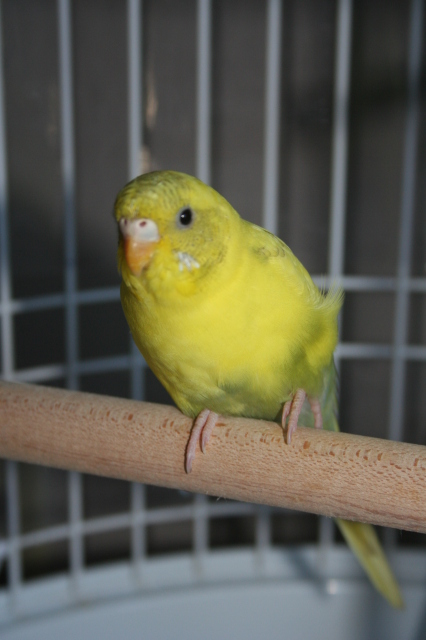 Budgie has broken foot?
Question
Maggies foot
Hi there! I got a baby budgie a f
Budgie has broken foot?
Question
Maggies foot
Hi there! I got a baby budgie a f
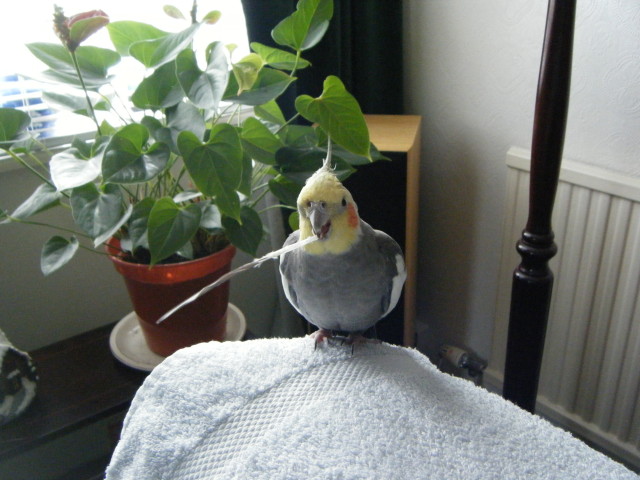 boris the cockatiel
Question
boris
Hello , I have a male cockatiel called b
boris the cockatiel
Question
boris
Hello , I have a male cockatiel called b
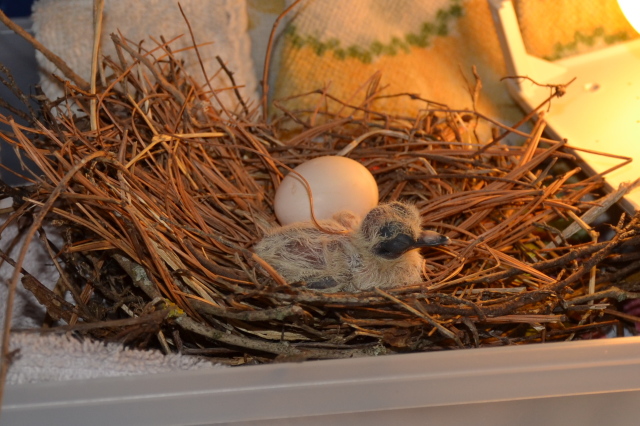 mourning dove
Question
baby mourning dove
Hello,
My boys found a baby
mourning dove
Question
baby mourning dove
Hello,
My boys found a baby
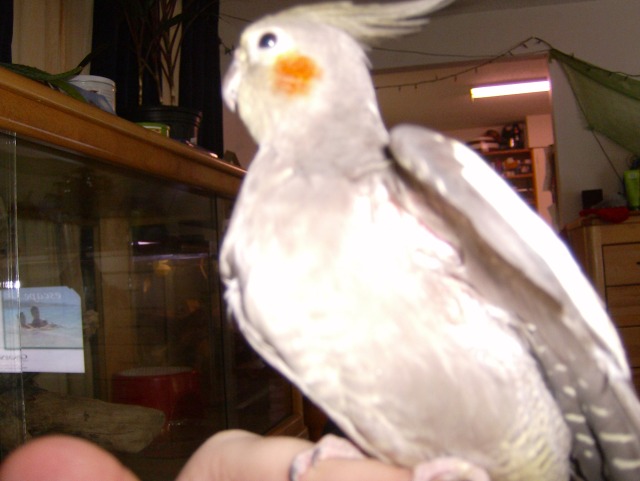 my cockitale mocha
QuestionQUESTION: I have a cokitale that will be 3 on A
my cockitale mocha
QuestionQUESTION: I have a cokitale that will be 3 on A
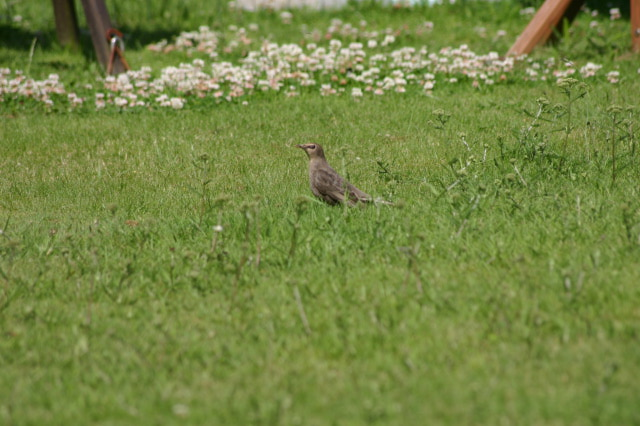 Identification of a bird
Question
Bird name
Please can you advise what th
Identification of a bird
Question
Bird name
Please can you advise what th